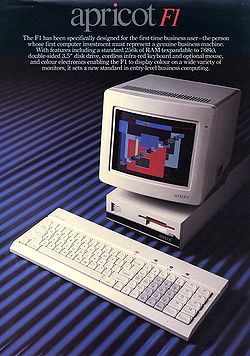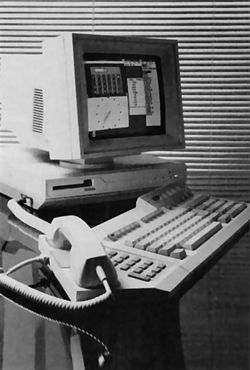Difference between revisions of "Apricot PC"
ZilogMonkey (Talk | contribs) (→Apricot Computers) |
ZilogMonkey (Talk | contribs) |
||
| Line 1: | Line 1: | ||
| + | [[Image:Apricot_pc_1.jpg|thumb|Apricot PC|right|250px]] | ||
| − | + | [[Image:Apricot_f1.jpg|thumb|Apricot PC|right|250px]] | |
| + | |||
| + | [[Image:Apricot_xen.jpg|thumb|Apricot PC|right|250px]] | ||
== Apricot Computers == | == Apricot Computers == | ||
Revision as of 03:39, 16 April 2010
Apricot Computers
Apricot Computers was a British company that manufactured business personal computers. It was originally founded in 1965 as "Applied Computer Techniques (ACT)". History
ACT released their first microcomputer in 1982. Although the computer was built by another company, it was marketed under the ACT brand. Towards the end of 1982, ACT signed a deal with Vistor to distribute the "Victor 9000", but under the name "Sirius 1" in Europe. Its price tag in the UK was £2754 and was a commercial success. In the US, however, it was not popular, possibly because was not an IBM-compatible PC.
In September 1983 the Apricot PC was released, based on an Intel 8086 microprocessor running at 4.77MHz. It ran MS-DOS or CP/M but was not compatible at a hardware level with the IBM PC. The graphics quality was critically acclaimed, with a 800 x 400 resolution and a keyboard with 8 "normal" and 6 flat programmable function keys along with a built-in LCD screen (40 characters / 2 lines) which displayed the function of the keys. Microsoft Word and Multiplan were supplied with the Apricot PC.
In 1984 ACT released a home computer, the "Apricot F1". It ran MS-DOS with "Activity", a GUI front end; like the Apricot PC, it was not IBM PC compatible. The machine was only successful in the UK. It was bundled with software for graphics, communication, word processing and system tools. The same infra-red trackball pointing device used with the Apricot Portable was also available for the F1. Also in 1984, the Apricot Portable was released, with an infra-red keyboard, a voice system, 5MHz CPU, 640 x 200 LCD display for £1965.
In 1985 ACT was renamed "Apricot Computers". By this time, the F1 had become one model in the F Series; other machines in the series were the F1e (a cheaper F1 with less RAM); the F2 (with two floppy drives) and the F10 (with a 10Mb hard drive and a more conventional-looking infra-red keyboard). The Activity GUI was replaced by GEM.
The last Apricot computer not to be IBM compatible was the XEN (October 1985), a 286-based system intended to compete with the IBM AT and running Windows 1.0. It was superseded in 1986 by the XEN-i, the first in a line of IBM compatible systems.
Although Apricot's proprietary computers were successful in the UK, the IBM PC had achieved critical mass in the US market before Apricot could make a dent. Eventually, Apricot switched to production of IBM compatibles, but was eventually bought by Mitsubishi and closed down.


